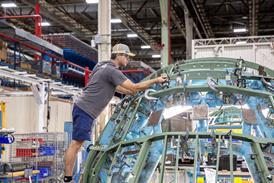NASA is confident it knows how cracks in the Space Shuttle’s external tank (ET) insulation propagate and lead to the foam loss that caused Space Shuttle Columbia’s destruction in 2003, but its engineers still do not know why the cracks begin.
The agency believes the cracking relates to the “chill down” caused by loading liquid oxygen and hydrogen into the ET and the pressurisation of the tank in readiness for launch. The ET has two layers of foam – a 25.4mm (1in) thick layer that goes round the ET and a second up to 254mm thick that protects cables and piping.
When the cold lower layer becomes brittle and shrinks due to chill down, a shear stress layer is generated where the upper foam meets the lower foam.
“We now have finite element analysis models of the foam and a map model of the stress fields of the two foam layers,” says NASA.
Source: Flight International




















